Uncovering the Carbon Emission Intensity and Reduction Potentials of the Metro Operation Phase: A Case Study in Shenzhen Megacity
Abstract
:1. Introduction
2. Methodology
2.1. Scope and System Boundary
2.2. Carbon Emissions Calculation Method
2.3. Data Inventory
2.4. Scenario Setting
3. Results
3.1. Energy Consumption Efficiency and Carbon Emission Characteristics of the Metro in the Operational Stage
3.2. Analysis of the Carbon Emission Reduction Potential of the Metro Operational Stage
4. Discussion
4.1. Comparison of Urban Public Transportation Modes in Shenzhen
4.2. Comparison of Metro Operational Stage in Different Cities
4.3. Suggestions
- (1)
- Formulate and implement relevant energy conservation and emission-reduction policies and standards in the field of urban public transportation. In terms of energy conservation and emission reduction, Shenzhen has made great efforts to build green-energy infrastructure and promote energy conservation, such as the Shenzhen Green Building Promotion Measures and the Shenzhen Special Economic Zone Green Building Regulations. However, there are no relevant policies or measures for energy conservation and emission reduction in the transportation field. Construction and transportation have always been high resource- and energy-consuming industries, and the environmental burden they bring to society cannot be ignored. Therefore, the introduction of energy-saving and emission-reduction policies and standards is necessary, and they are guaranteed to promote the low-carbon transformation of urban public transportation systems.
- (2)
- Reasonably plan the layouts of metro lines and improve the efficiency of metro transportation. Compared with foreign cities such as London and New York, metro construction in China started late, beginning in Shenzhen, for example, in the late 1990s. The study results show that the per capita carbon emissions of the Shenzhen Metro (0.6 kg CO2e) are similar to those of buses (0.54 kg CO2e) and are much lower than those of taxis (1.38 kg CO2e). Furthermore, the per capita carbon emissions curve of the metro shows a downward trend, indicating that the metro will play a vital role in reducing carbon emissions from urban public transportation in the future. In addition, at present, the full load rate of the Shenzhen Metro is relatively low. If the metro line layout can be well aligned with people’s travel needs, the metro’s share of passenger traffic can be further improved. Taking Tokyo, Japan, as an example, the construction of a compact metro is conducive to the sustainable development of a city [55]. Therefore, the Shenzhen Metro can learn from the mature experience of Tokyo and other cities, building metro systems to cover several different service levels; taking into consideration the area to be served, the travel demand characteristics, and travel time; improving the interconnection of metro lines at different service levels; and promoting the formation of an integrated metro network.
- (3)
- Optimize the energy structure, improve the efficiency of thermal power generation and clean transformation, increase the proportion of new clean energy, and realize the zero-carbon transformation of energy. Although the electricity consumed by metro operations does not directly produce greenhouse gases, metro energy utilization can be improved, and the upstream production of this electricity also needs to be considered. Optimizing the energy structure can reduce emissions by up to 32% per year, with a reduction of about 1.35 Mt CO2e (Scenario III in 2035). Clean energy generation plays an important role in the low-carbon transformation of transportation. In particular, photovoltaic systems can be widely used on the roofs of stations and depots to share energy consumption for the operation of station lighting systems. The photovoltaic electricity generation system can generate up to 47.106 million kWh of electricity per year, and the emission reduction is about 289,000 tCO2e (Scenario III in 2035). In the future, more clean energy technologies should be explored, especially photovoltaic electricity generation systems (such as perovskite photovoltaic (PV) cells) [56,57], to introduce greater carbon emission reduction benefits to the subway system.
- (4)
- Promote energy-saving and emission-reduction technologies and schemes. The result shows that the energy-saving equipment used in Shenzhen’s Metro (frequency-conversion air conditioners, LED energy-saving lamps, frequency-conversion escalators, etc.), as well as photovoltaic electricity generation technology and regenerative braking energy recovery technology (realized for the first time in Shenzhen on the metro line), can achieve a significant carbon emission reduction effect. The research results show that photovoltaic electricity generation technology can generate 50 million kWh per year, regenerative braking energy recovery technology can recover 190 million kWh per year, and energy-saving lamps, frequency-conversion air conditioners and frequency-conversion escalators can save 1.18 billion kWh per year (Scenario III in 2035). However, since energy-saving and emission-reduction technology have not yet been fully implemented in the Shenzhen Metro, the use of emission-reduction technology should be further expanded in the future.
4.4. Constraints and Limitations
5. Conclusions
Supplementary Materials
Author Contributions
Funding
Institutional Review Board Statement
Informed Consent Statement
Data Availability Statement
Conflicts of Interest
References
- IEA. World Energy Outlook 2021, International Energy Agency (IEA). 2021. Available online: https://gotcp.net/wp-content/uploads/2021/10/WEO2021_Launch_Presentation-1.pdf (accessed on 10 November 2022).
- MEEPR. The Third National Communication on Climate Change of the People’s Republic of China, Ministry of Ecology and Environment of the People’s Republic of China (MEEPR). 2019. Available online: https://www.mee.gov.cn (accessed on 10 November 2022).
- Zhang, Y.J.; Jiang, L.; Shi, W. Exploring the growth-adjusted energy-emission efficiency of transportation industry in China. Energ. Econ. 2020, 90, 104873. [Google Scholar] [CrossRef]
- NDRC. National Plan Against Climate Change (2014–2020), National Development and Reform Commission of China (NDRC). 2014. Available online: https://www.ndrc.gov.cn (accessed on 10 November 2022).
- SBS. Yearbook of Shenzhen Statistics (2005–2021), Statistics Bureau of Shenzhen (SBS). 2016. Available online: http://tjj.sz.gov.cn (accessed on 10 November 2022).
- Gao, J.; Ma, S.; Li, L.; Zuo, J.; Du, H. Does travel closer to TOD have lower CO2 emissions? Evidence from ride-hailing in Chengdu, China. J. Environ. Manag. 2022, 308, 114636. [Google Scholar] [CrossRef]
- Loy-Benitez, J.; Heo, S.K.; Yoo, C.K. Imputing missing indoor air quality data via variational convolutional autoencoders: Implications for ventilation management of subway metro systems. Build. Environ. 2020, 182, 107135. [Google Scholar] [CrossRef]
- Zhang, S.Y.; Zhao, J.M. Low-carbon futures for Shenzhen’s urban passenger transport: A human-based approach. Transp. Res. Part D Transp. Environ. 2018, 62, 236–255. [Google Scholar] [CrossRef]
- SCPLRC. Shenzhen Rail Transit Network Planning (2016–2035), Shenzhen City Planning and Land Resources Committee (SCPLRC). 2017. Available online: http://pnr.sz.gov.cn (accessed on 10 November 2022).
- Zhang, N.; Zhou, P.; Kung, C.C. Total-factor carbon emission performance of the Chinese transportation industry: A bootstrapped non-radial Malmquist index analysis. Renew. Sustain. Energy Rev. 2015, 41, 584–593. [Google Scholar] [CrossRef]
- Nyhan, M.; Sobolevsky, S.; Kang, C.; Robinson, P.; Corti, A.; Szell, M.; Streets, D.; Lu, Z.; Britter, R. Predicting vehicular emissions in high spatial resolution using pervasively measured transportation data and microscopic emissions model. Atmos. Environ. 2016, 140, 352–363. [Google Scholar] [CrossRef]
- Liu, F.; Zhao, F.; Liu, Z.; Hao, H. The impact of fuel cell vehicle deployment on road transport greenhouse gas emissions: The China case. Int. J. Hydrogen Energy 2018, 43, 22604–22621. [Google Scholar] [CrossRef]
- Zheng, F.; Gu, F.; Zhang, W.; Guo, J. Is bicycle sharing an environmental practice? Evidence from a life cycle assessment based on behavioral surveys. Sustainability 2019, 11, 1550. [Google Scholar] [CrossRef] [Green Version]
- Kou, Z.; Wang, X.; Chiu, S.F.A.; Cai, H. Quantifying greenhouse gas emissions reduction from bike share systems: A model considering real-world trips and transportation mode choice patterns. Resour. Conserv. Recycl. 2020, 153, 104534. [Google Scholar] [CrossRef]
- Mao, G.; Hou, T.; Liu, X.; Zuo, J.; Kiyawa, A.H.I.; Shi, P.; Sandhu, S. How can bicycle-sharing have a sustainable future? A research based on life cycle assessment. J. Clean. Prod. 2021, 282, 125081. [Google Scholar] [CrossRef]
- Jung, J.; Koo, Y. Analyzing the effects of car sharing services on the reduction of greenhouse gas (GHG) emissions. Sustainability 2018, 10, 539. [Google Scholar] [CrossRef] [Green Version]
- Del Pero, F.; Delogu, M.; Pierini, M.; Bonaffini, D. Life Cycle Assessment of a heavy metro train. J. Clean. Prod. 2015, 87, 787–799. [Google Scholar] [CrossRef]
- Lajunen, A.; Lipman, T. Lifecycle cost assessment and carbon dioxide emissions of diesel, natural gas, hybrid electric, fuel cell hybrid and electric transit buses. Energy 2016, 106, 329–342. [Google Scholar] [CrossRef]
- Mao, R.; Bao, Y.; Duan, H.; Liu, G. Global urban subway development, construction material stocks, and embodied carbon emissions. Humanit. Soc. Sci. Commun. 2021, 8, 1–11. [Google Scholar] [CrossRef]
- Guo, B.; Geng, Y.; Franke, B.; Hao, H.; Liu, Y.; Chiu, A. Uncovering China’s transport CO2 emission patterns at the regional level. Energy Policy 2014, 74, 134–146. [Google Scholar] [CrossRef]
- Duan, H.; Hu, M.; Zhang, Y.; Wang, J.; Jiang, W.; Huang, Q.; Li, J. Quantification of carbon emissions of the transport service sector in China by using streamlined life cycle assessment. J. Clean. Prod. 2015, 95, 109–116. [Google Scholar] [CrossRef]
- Xu, B.; Lin, B.Q. Differences in regional emissions in China’s transport sector: Determinants and reduction strategies. Energy 2016, 95, 459–470. [Google Scholar] [CrossRef]
- Noshadravan, A.; Cheah, L.; Roth, R.; Freire, F.; Dias, L.; Gregory, J. Stochastic comparative assessment of life-cycle greenhouse gas emissions from conventional and electric vehicles. Int. J. Life Cycle Assess. 2015, 20, 854–864. [Google Scholar] [CrossRef] [Green Version]
- Fan, J.L.; Wang, J.X.; Li, F.; Yu, H.; Zhang, X. Energy demand and greenhouse gas emissions of urban passenger transport in the Internet era: A case study of Beijing. J. Clean. Prod. 2017, 165, 177–189. [Google Scholar] [CrossRef]
- Lopes Toledo, A.L.; La Rovere, E.L. Urban mobility and greenhouse gas emissions: Status, public policies, and scenarios in a developing economy city, Natal, Brazil. Sustainability 2018, 10, 3995. [Google Scholar] [CrossRef]
- Del Pero, F.; Delogu, M.; Pierini, M. Life Cycle Assessment in the automotive sector: A comparative case study of Internal Combustion Engine (ICE) and electric car. Procedia Struct. Integr. 2018, 12, 521–537. [Google Scholar] [CrossRef]
- Zhang, L.; Li, Z.; Jia, X.; Tan, R.R.; Wang, F. Targeting carbon emissions mitigation in the transport sector–A case study in Urumqi, China. J. Clean. Prod. 2020, 259, 120811. [Google Scholar] [CrossRef]
- Duan, H.; Hu, M.; Zuo, J.; Zhu, J.; Mao, R.; Huang, Q. Assessing the carbon footprint of the transport sector in mega cities via streamlined life cycle assessment: A case study of Shenzhen, South China. Int. J. Life Cycle Assess. 2017, 22, 683–693. [Google Scholar] [CrossRef]
- Dong, D.; Duan, H.B.; Mao, R.C.; Song, Q.; Zuo, J.; Zhu, J.; Wang, G.; Hu, M.; Dong, B.; Liu, G. Towards a low carbon transition of urban public transport in megacities: A case study of Shenzhen, China. Resour. Conserv. Recycl. 2018, 134, 149–155. [Google Scholar] [CrossRef]
- Liu, M.H.; Jia, S.Y.; Liu, X. Evaluation of mitigation potential of GHG emissions from the construction of prefabricated subway station. J. Clean. Prod. 2019, 236, 117700. [Google Scholar] [CrossRef]
- Shen, J.L.; Gao, Z. Commuter exposure to particulate matters in four common transportation modes in Nanjing. Build. Environ. 2019, 156, 156–170. [Google Scholar] [CrossRef]
- Lederer, J.; Ott, C.; Brunner, P.H.; Ossberger, M. The life cycle energy demand and greenhouse gas emissions of high-capacity urban transport systems: A case study from Vienna’s subway line U2. Int. J. Sustain. Transp. 2016, 10, 120–130. [Google Scholar] [CrossRef]
- Li, Y.; He, Q.; Luo, X.; Zhang, Y.; Dong, L. Calculation of life-cycle greenhouse gas emissions of urban rail transit systems: A case study of Shanghai Metro. Resour. Conserv. Recycl. 2018, 128, 451–457. [Google Scholar] [CrossRef]
- Saxe, S.; Miller, E.; Guthrie, P. The net greenhouse gas impact of the Sheppard Subway Line. Transp. Res. Part D Transp. Environ. 2017, 51, 261–275. [Google Scholar] [CrossRef] [Green Version]
- SETAC. Guidelines for Life-Cycle Assessment: A ‘Code of Practice’ from the workshop held at Sesimbra, Portugal, 31 March–3 April 1993 Society of Environmental Toxicology and Chemistry (SETAC). Environ. Sci. Pollut. Res. Int. 1994, 1, 55. [Google Scholar] [CrossRef]
- Finkbeiner, M.; Inaba, A.; Tan, R.; Christiansen, K.; Klüppel, H.J. The new international standards for life cycle assessment: ISO 14040 and ISO 14044. Int. J. Life Cycle Assess. 2006, 11, 80–85. [Google Scholar] [CrossRef]
- Benoît-Norris, C.; Vickery-Niederman, G.; Valdivia, S.; Franze, J.; Traverso, M.; Ciroth, A.; Mazijn, B. Introducing the UNEP/SETAC methodological sheets for subcategories of social LCA. Int. J. Life Cycle Assess. 2011, 16, 682–690. [Google Scholar] [CrossRef]
- Olivetti, E.; Patanavanich, S.; Kirchain, R. Exploring the viability of probabilistic under-specification to streamline life cycle assessment. Environ. Sci. Technol. 2013, 47, 5208–5216. [Google Scholar] [CrossRef]
- ISO 14040:2006; Environmental Management—Life Cycle Assessment—Principles and Framework. ISO: Geneva, Switzerland, 2006.
- ISO 14044:2006; Environmental Management—Life cycle Assessment—Requirements and Guidelines. ISO: Geneva, Switzerland, 2006.
- National Development and Reform Commission (NDRC). China Regional Power Grid Baseline Emission Factor (2006–2019). 2020. Available online: https://www.ndrc.gov.cn (accessed on 10 November 2022).
- Transport Commission of Shenzhen Municipality (TCSM). The Transport Production Statistics Monthly Report (2010–2021). 2021. Available online: http://jtys.sz.gov.cn (accessed on 10 November 2022).
- Shenzhen Transportation Bureau (STB). Phase IV Construction Plan of Shenzhen Urban Rail Transit (2017–2022). 2018. Available online: http://jtys.sz.gov.cn (accessed on 10 November 2022).
- Lin, B.Q. China Energy Development Report (2020); Peking University Press: Beijing, China, 2020. (In Chinese) [Google Scholar]
- The State Council (SC). Notice of the State Council on Printing and Distributing the Action Plan for Carbon Peak before 2030. 2021. Available online: http://www.gov.cn (accessed on 10 November 2022).
- Ministry of Ecology and Environment of the People’s Republic of China (MEEPR). Building Energy Conservation and Green Building Development Planning in the 14th Five Year Plan. 2022. Available online: https://www.mee.gov.cn (accessed on 10 November 2022).
- Statistics Bureau of Shenzhen (SBS). Shenzhen Comprehensive Transportation “14th Five Year Plan”. 2022. Available online: http://tjj.sz.gov.cn (accessed on 10 November 2022).
- Ma, Z.K. Study on Energy Consumption Estimation of Urban Rail Transit System Considering Line Operation Characteristics; Beijing Jiaotong University: Beijing, China, 2016. (In Chinese) [Google Scholar]
- Shenzhen Metro. Annual Report of Shenzhen Metro Group Co., Ltd. in 2015. 2016. Available online: https://www.szmc.net/public/cms/public/upload/infor/attach/2016-06-28/1467100592254.pdf (accessed on 10 November 2022).
- Shenzhen Metro. Annual Report of Shenzhen Metro Group Co., Ltd. in 2020. 2021. Available online: https://www.szmc.net/SMARTC/upload/file/20210630/1625040793049090587.pdf (accessed on 10 November 2022).
- Chi, L.B. Research on Urban Taxi’s Air Pollution Calculation Method and Emission Reduction Strategies; Harbin Institute of Technology: Harbin, China, 2016. (In Chinese) [Google Scholar]
- China Electric Power Construction Association (CEPCA). China Power Construction Industry Development Report (2020). 2020. Available online: http://www.cepca.org.cn (accessed on 10 November 2022).
- China Association of Metros (CAM). Statistics and Analysis Report of Urban Rail Transit in 2021. 2022. Available online: https://www.camet.org.cn/xhfb/9935 (accessed on 10 November 2022).
- The State Council (SC). Outline of Development Planning of Guangdong Hong Kong Macao Bay Area. 2019. Available online: http://www.gov.cn (accessed on 10 November 2022).
- Yuan, H.; He, Y.; Zhou, J.; Li, Y.; Cui, X.; Shen, Z. Research on compactness ratio model of urban underground space and compact development mechanism of rail transit station affected area. Sustain. Cities Soc. 2020, 55, 102043. [Google Scholar] [CrossRef]
- Li, B.; Guo, W.; Liu, X.; Zhang, Y.; Caneparo, L. The third solar decathlon China buildings for achieving carbon neutrality. Buildings 2022, 12, 1094. [Google Scholar] [CrossRef]
- Xiang, X.; Ma, X.; Ma, Z.; Ma, M. Operational carbon change in commercial buildings under the carbon neutral goal: A LASSO–WOA approach. Buildings 2022, 12, 54. [Google Scholar] [CrossRef]
- Shenzhen Transportation Bureau (STB). The Transport Production Statistics Monthly Report (2010–2021). 2021. Available online: http://jtys.sz.gov.cn (accessed on 10 November 2022).
- National Development and Reform Commission (NDRC). Shenzhen Transportation Bureau Phase IV construction plan of Shenzhen Urban Rail Transit (2017–2022). 2018. Available online: https://www.ndrc.gov.cn (accessed on 10 November 2022).
- Guo, M.X.; Cai, W.J.; Wang, C.; Chen, J.N. Quantifying CO2 emissions of one wind farm using life cycle assessment and uncertainty analysis. China Environ. Sci. 2012, 32, 742–747. (In Chinese) [Google Scholar]
- Chen, G.Q.; Yang, Q.; Zhao, Y.H.; Wang, Z.F. Nonrenewable energy cost and greenhouse gas emissions of a 1.5 MW solar power tower plant in China. Renew. Sustain. Energy Rev. 2011, 15, 1961–1967. [Google Scholar] [CrossRef]
- Guangdong Provincial Bureau of Statistics (GPBS). Energy Statistics. Statistical Data of Electric Power Industry (2014). 2015. Available online: http://stats.gd.gov.cn (accessed on 10 November 2022).
- China Energy Research Society (CERS). China Energy Outlook 2030. 2016. Available online: https://www.cers.org.cn (accessed on 10 November 2022).
- Zhou, N.; Fridley, D.; McNeil, M.; Zheng, N.; Ke, J.; Levine, M. China’s Energy and Carbon Emissions Outlook to 2050; Lawrence Berkeley National Lab. (LBNL): Berkeley, CA, USA, 2011. [Google Scholar]
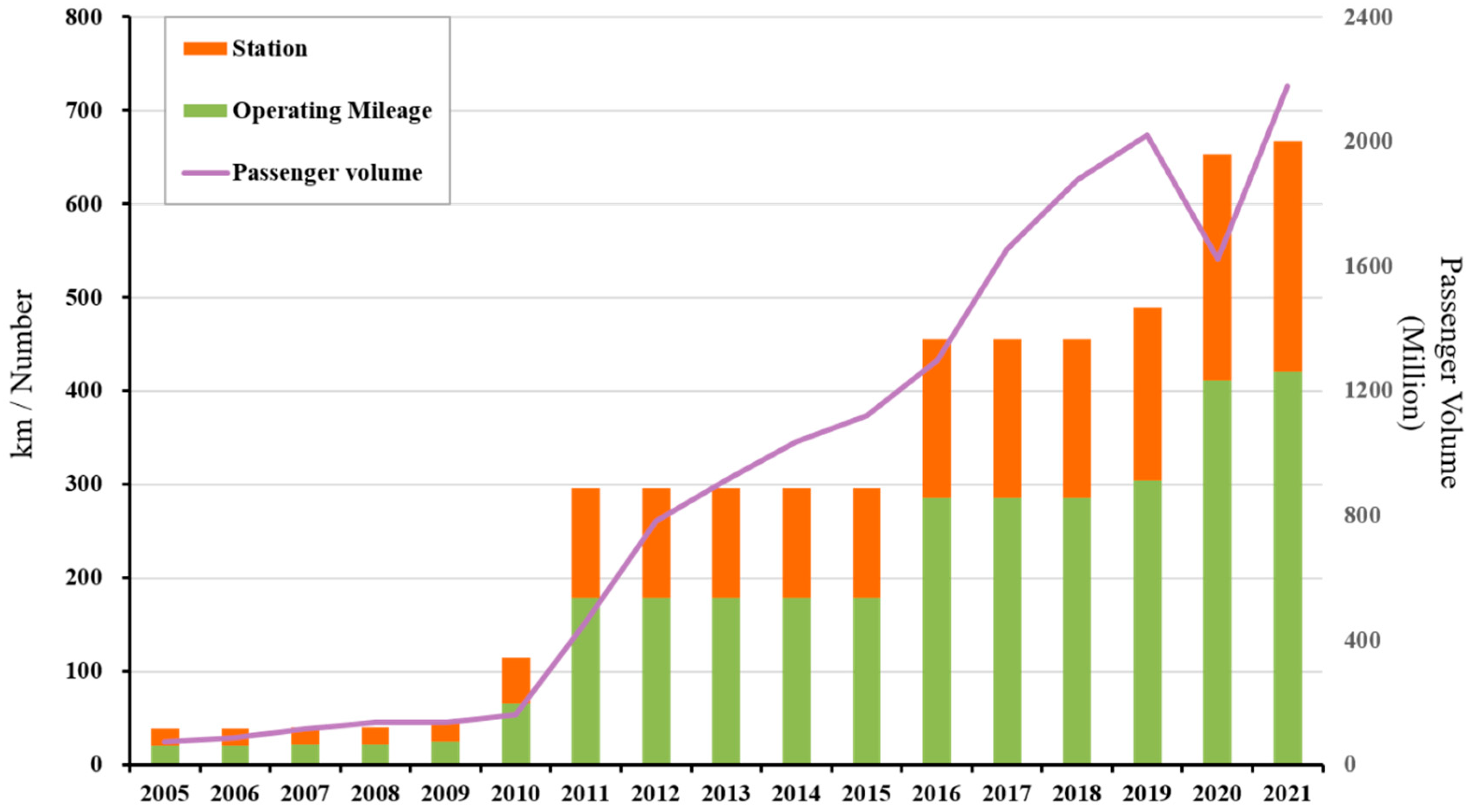
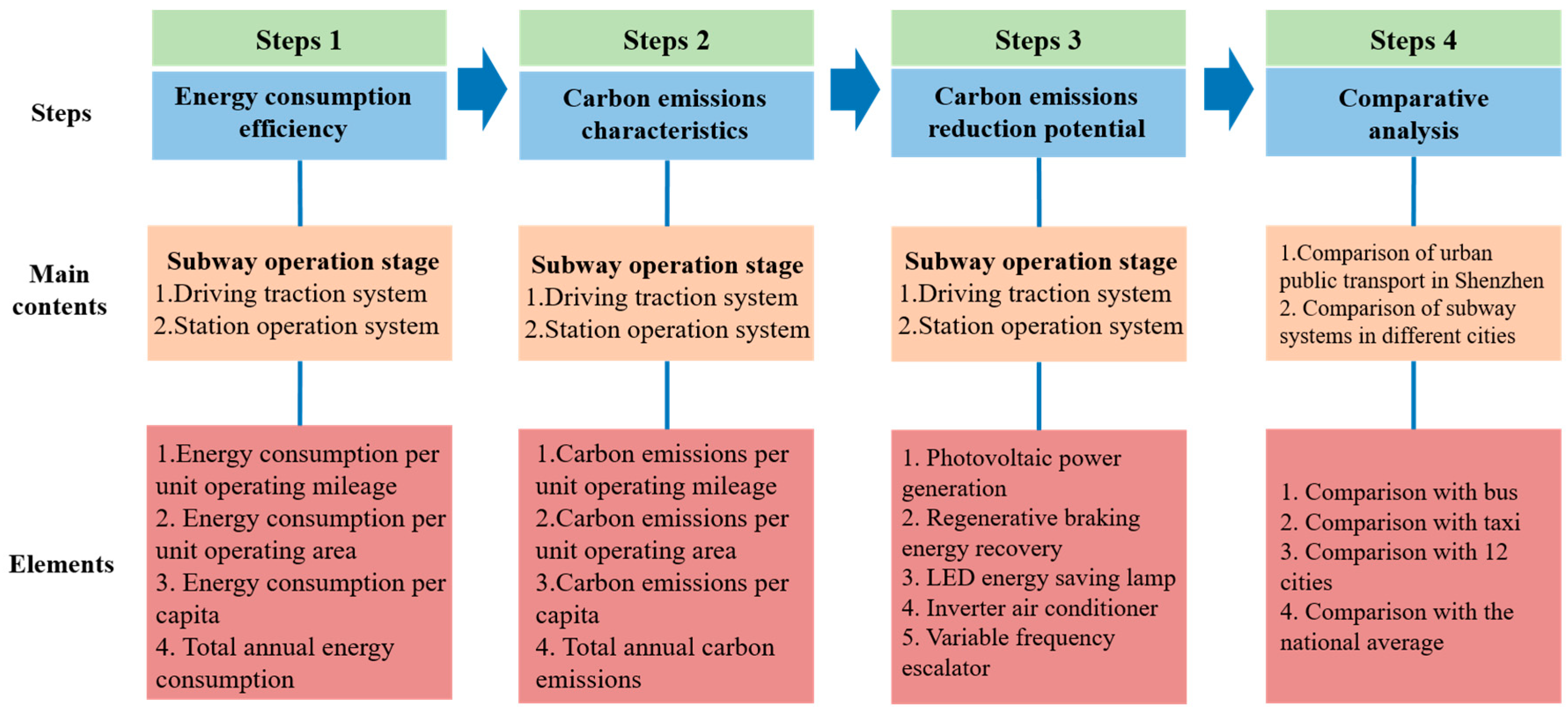
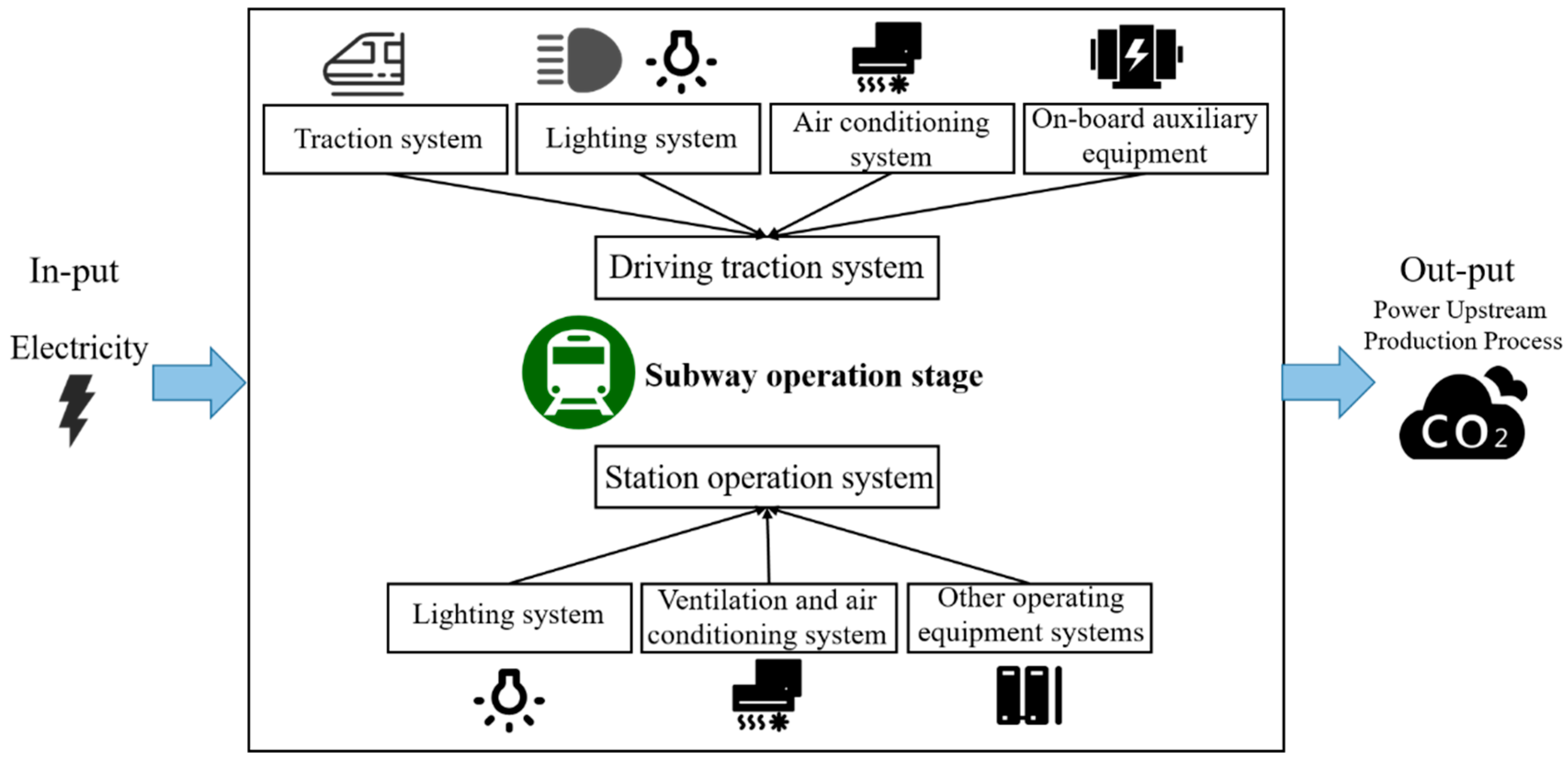
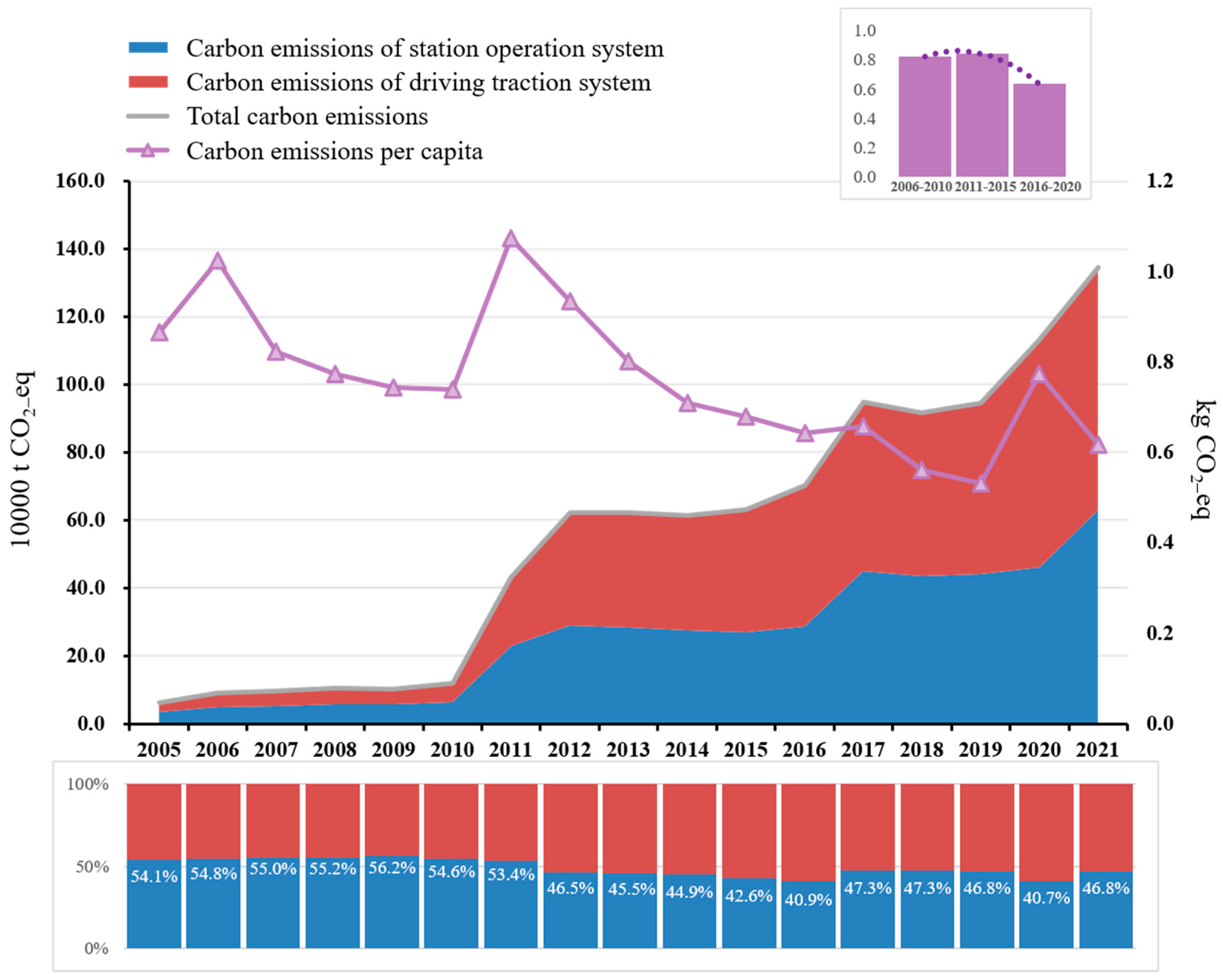
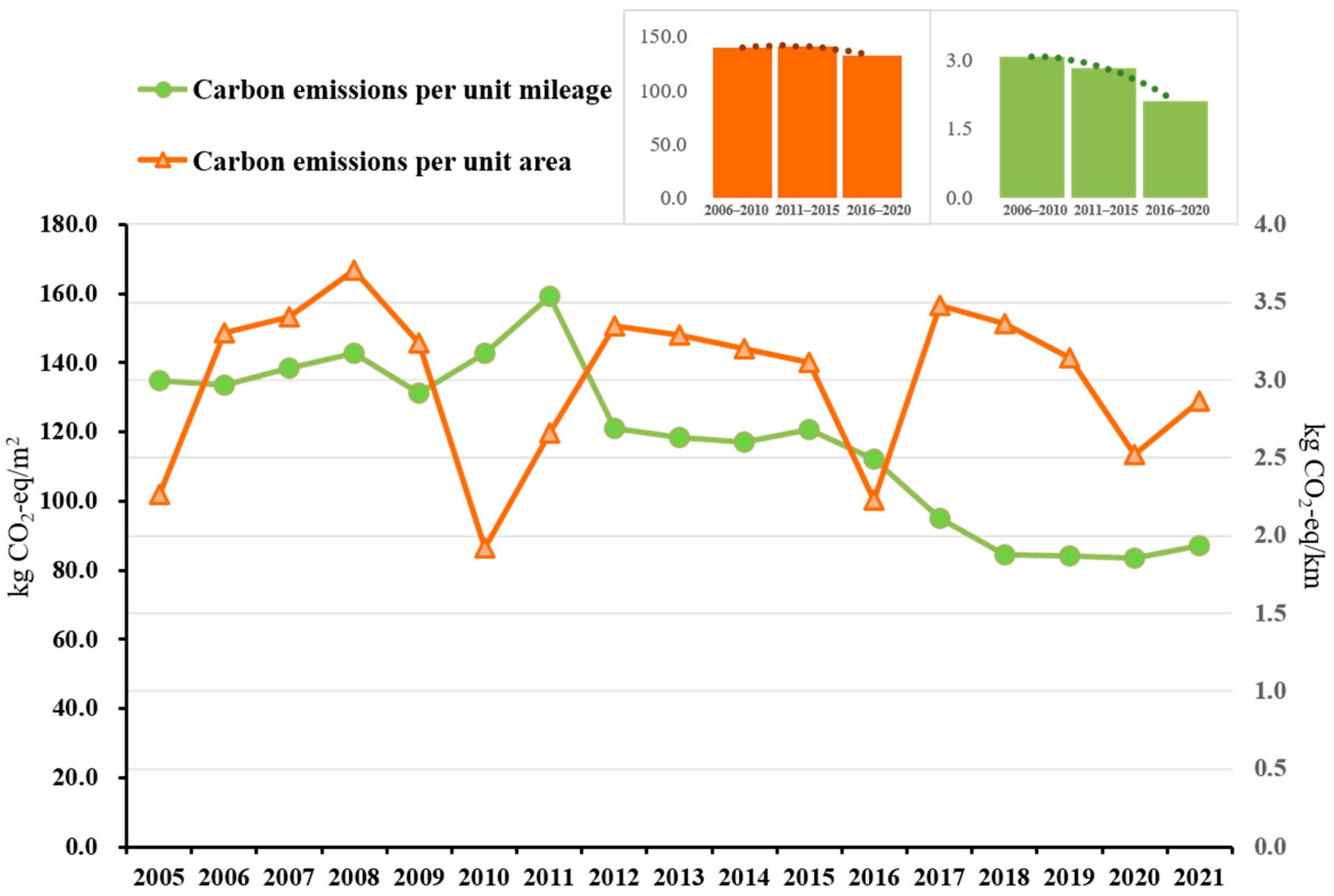
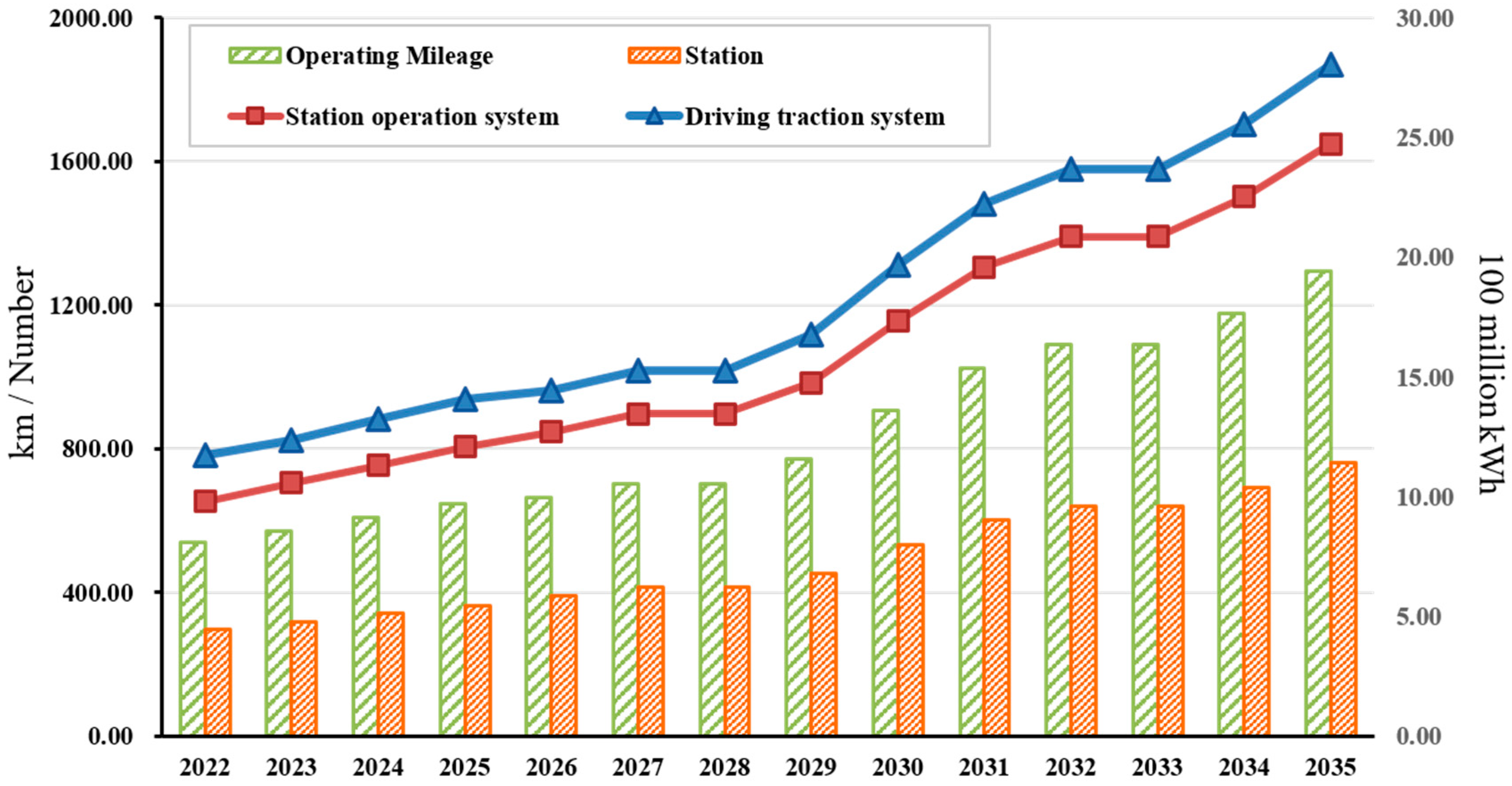
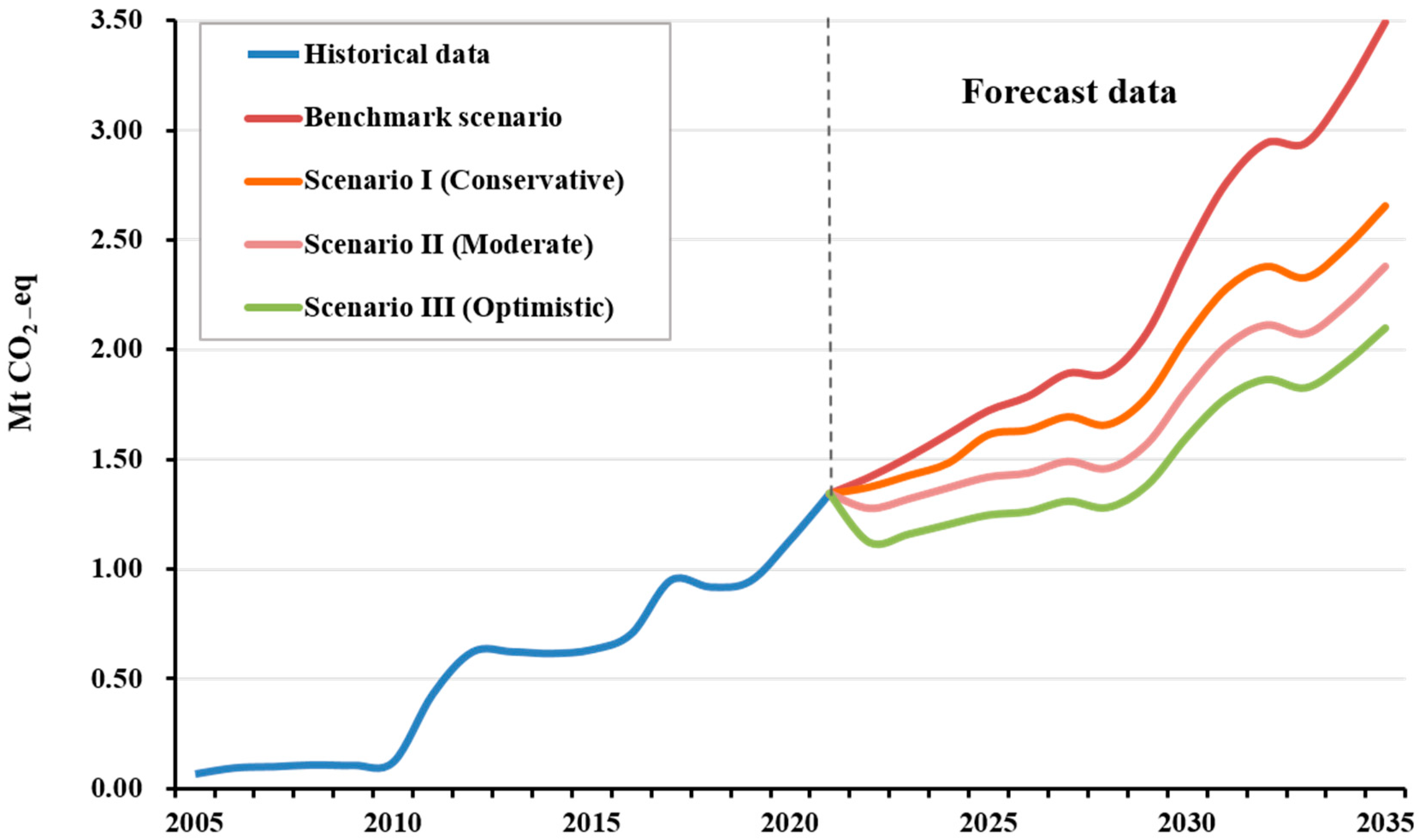
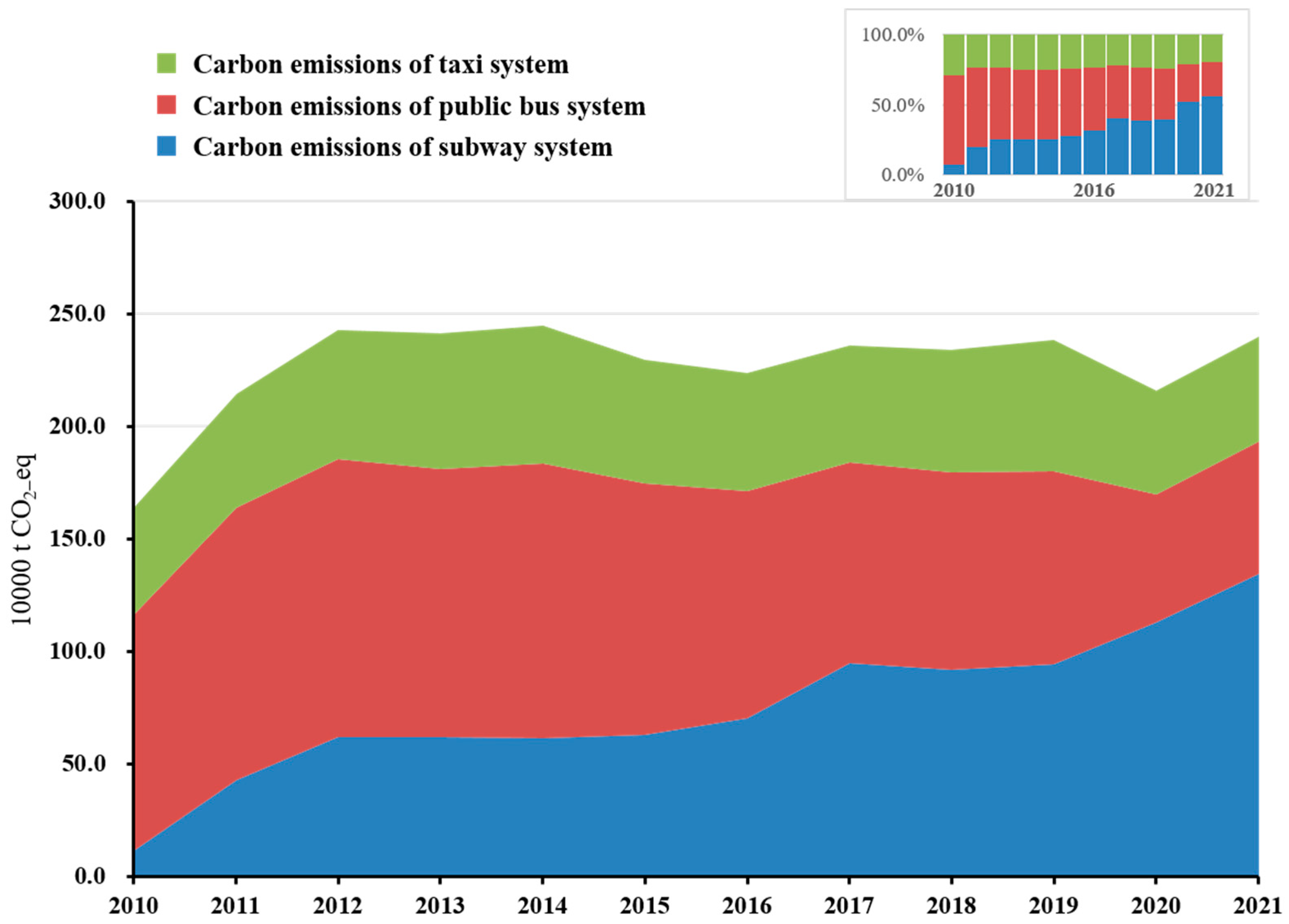

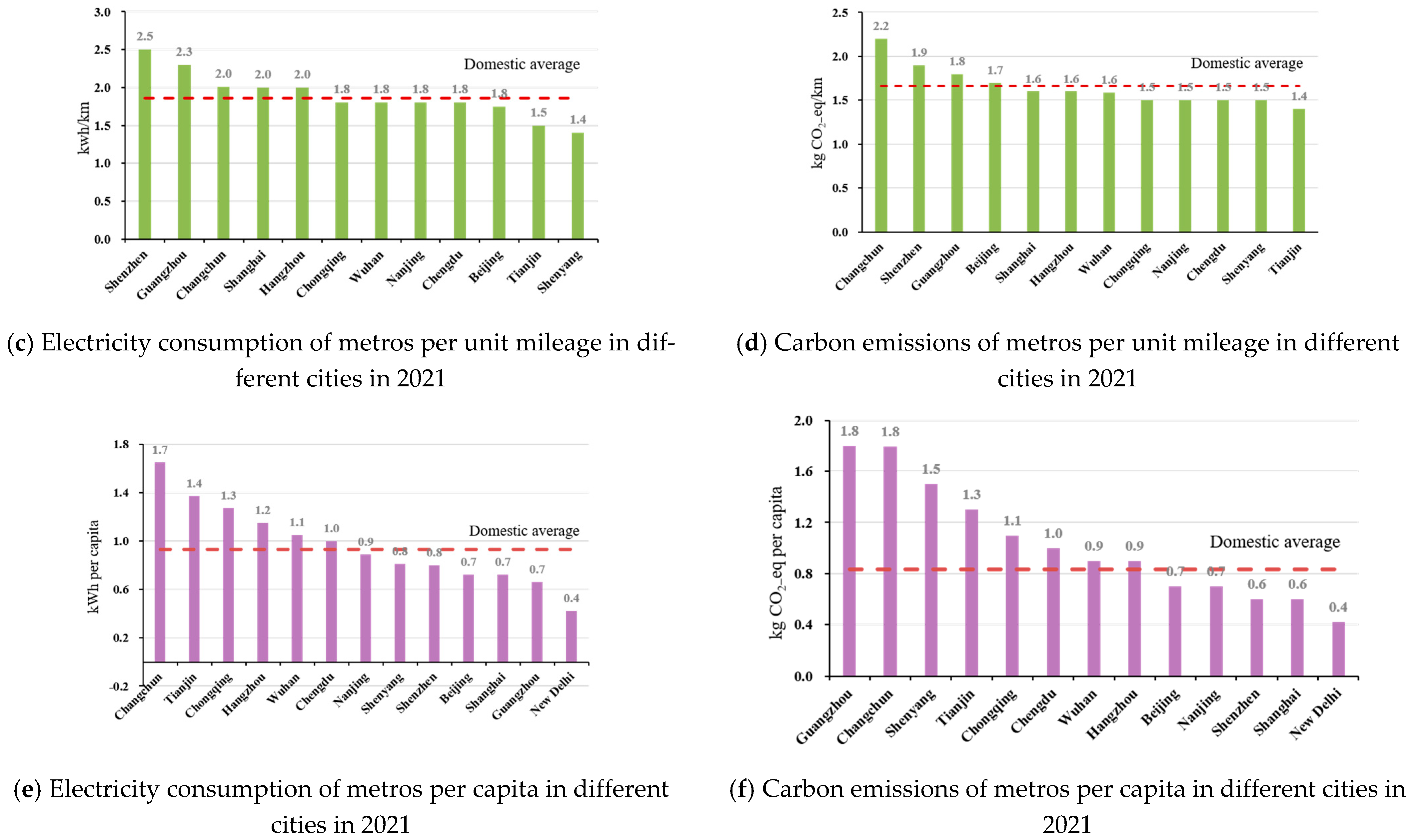
| Indicator | Benchmark Scenario | Scenario I (Conservative) | Scenario II (Moderate) | Scenario III (Optimistic) | ||||
|---|---|---|---|---|---|---|---|---|
| 2025 | 2035 | 2025 | 2035 | 2025 | 2035 | 2025 | 2035 | |
| Photovoltaic electricity generation | 28% | 28% | 39% | 60% | 48% | 80% | 54% | 90% |
| Regenerative braking energy recovery | 3% | 3% | 12% | 30% | 21% | 50% | 34% | 80% |
| LED energy-saving lamps | 89% | 89% | 97% | 100% | 100% | 100% | 100% | 100% |
| Inverter air conditioners | 65% | 65% | 82% | 100% | 94% | 100% | 100% | 100% |
| Variable-frequency escalators | 90% | 90% | 94% | 100% | 100% | 100% | 100% | 100% |
| Electricity carbon emission factor (kg CO2e/kWh) | 0.799 | 0.799 | 0.784 | 0.664 | 0.713 | 0.604 | 0.641 | 0.543 |
| Level | Resource Code | Annual Total Radiation (MJ/m2) | Annual Total Radiation (kWh/m2) | Average Daily Radiation (kWh/m2) |
|---|---|---|---|---|
| Zone of maximum abundance | I | ≥6300 | ≥1750 | ≥4.8 |
| Zone of abundance | II | 5040~6300 | 1400~1750 | 3.98~4.8 |
| More abundant zone | III | 3780~5040 | 1050~1400 | 2.9~3.93 |
| General | IV | <3780 | <1050 | <2.9 |
| City | Beijing | Shanghai | Guangzhou | Shenzhen | Chengdu | Wuhan | Chongqing | Nanjing | Hangzhou | Tianjin | Changchun | Shenyang |
|---|---|---|---|---|---|---|---|---|---|---|---|---|
| Lines | 23 | 18 | 13 | 12 | 12 | 11 | 7 | 5 | 9 | 7 | 2 | 4 |
| Mileage (km) | 709.9 | 795.4 | 505.7 | 420.6 | 518.5 | 435.3 | 271 | 182.2 | 342 | 211.8 | 43 | 114.1 |
| Stations | 390 | 486 | 296 | 247 | 327 | 275 | 208 | 200 | 185 | 179 | 126 | 161 |
| Passenger volume (100 million passengers) | 30.4 | 35.6 | 21.8 | 21.8 | 12.1 | 10.0 | 7.1 | 7.9 | 8.9 | 4.1 | 1.3 | 3.8 |
Disclaimer/Publisher’s Note: The statements, opinions and data contained in all publications are solely those of the individual author(s) and contributor(s) and not of MDPI and/or the editor(s). MDPI and/or the editor(s) disclaim responsibility for any injury to people or property resulting from any ideas, methods, instructions or products referred to in the content. |
© 2022 by the authors. Licensee MDPI, Basel, Switzerland. This article is an open access article distributed under the terms and conditions of the Creative Commons Attribution (CC BY) license (https://creativecommons.org/licenses/by/4.0/).
Share and Cite
Chen, K.; Zhang, G.; Wu, H.; Mao, R.; Chen, X. Uncovering the Carbon Emission Intensity and Reduction Potentials of the Metro Operation Phase: A Case Study in Shenzhen Megacity. Int. J. Environ. Res. Public Health 2023, 20, 206. https://doi.org/10.3390/ijerph20010206
Chen K, Zhang G, Wu H, Mao R, Chen X. Uncovering the Carbon Emission Intensity and Reduction Potentials of the Metro Operation Phase: A Case Study in Shenzhen Megacity. International Journal of Environmental Research and Public Health. 2023; 20(1):206. https://doi.org/10.3390/ijerph20010206
Chicago/Turabian StyleChen, Kunyang, Guobin Zhang, Huanyu Wu, Ruichang Mao, and Xiangsheng Chen. 2023. "Uncovering the Carbon Emission Intensity and Reduction Potentials of the Metro Operation Phase: A Case Study in Shenzhen Megacity" International Journal of Environmental Research and Public Health 20, no. 1: 206. https://doi.org/10.3390/ijerph20010206





